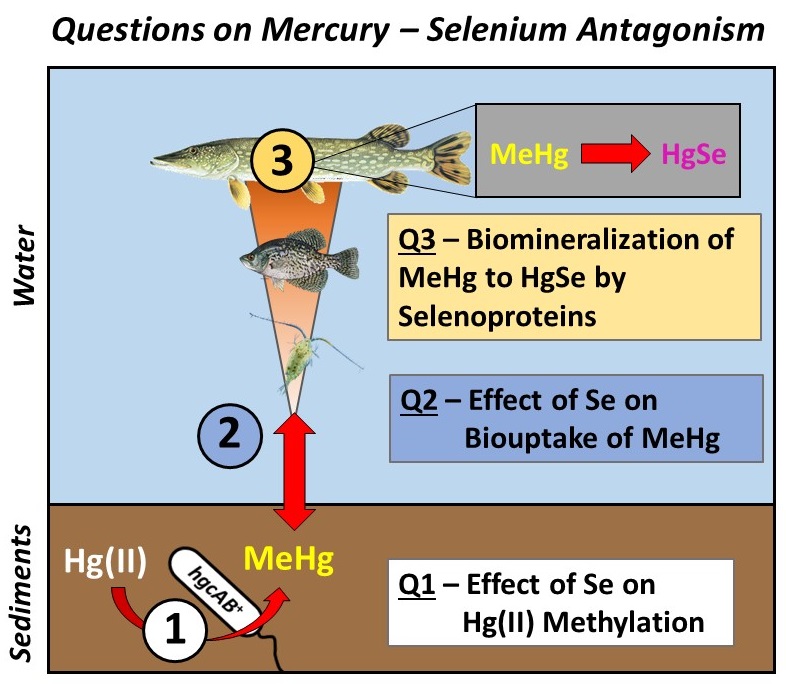Human activities have resulted in the release and perturbation of metal contaminants and have disrupted other element cycles that influence metals. Our research covers a variety of topics on metal contaminants, with a focus on the metal mercury (Hg). The overarching theme of our research is to address the scientific needs to advance understanding and propel mitigation of metal exposure in both man-made and natural environments. Active areas of research include:
- Mechanisms of Mercury-Selenium Interactions in the Environment
- Sulfur, Carbon, and Mercury Dynamics in Subtropical Wetlands
- Remediation of Arid-Land Reservoirs
- Fate of Permafrost Mercury and Carbon in Arctic Landscapes
- The Rusting of Arctic Rivers
- Toxic Metal Releases in E-cigarette Aerosols
Mechanisms of Mercury-Selenium Interactions in the Environment
Summary: The uptake of mercury in aquatic food webs is known to be influenced by interactions between mercury and selenium, generally termed “mercury-selenium antagonism”. This project aims to establish the mechanisms by which selenium influences the formation of toxic methylmercury, the uptake of methylmercury in biota, and the biomineralization of methylmercury to mercury selenide in higher organisms. The results are anticipated to permit improved management of complex freshwater environments and accurate risk assessment of mercury to wildlife and humans.
Project Members: Ben Peterson, Comfort Chukwuere, Emily Richter, Julia Davidson
Collaborations: Alain Manceau (Univ. Grenoble Alpes); Sarah Janssen and Collin Eagles-Smith (U.S. Geological Survey); Heidi Goenaga-Infante (LGC Group, UK); Michelle Villegas-Frazier (UC Davis Native American Academic Student Success Center).
Funding Source: NSF Geobiology and Low Temperature Geochemistry Program (EAR-2143243)

Sulfur, Carbon, and Mercury Dynamics in Subtropical Wetlands
Summary: Water quality remains one of the biggest issues facing the restoration of the Florida Everglades, an iconic ecosystem of subtropical wetlands. The Florida Everglades receive pressure from land use / water management decisions and from sea-level rise. This research project aims to provide the science to understand how internal drivers (e.g., water management or ecosystem restoration efforts) versus external drivers (e.g., sea-level rise) impact the cycling of sulfur, carbon, and mercury in the greater Everglades ecosystem. The goal is to improve the ability to predict the biogeochemical responses of the Florida Everglades to land and water management efforts and sea-level rise.
Project Members: Ben Peterson, Ania Szlembarska, Bryce Cook
Collaborations: Dave Krabbenhoft, Sarah Janssen, and Collin Eagles-Smith (U.S. Geological Survey)
Funding Sources and Support: U.S. Geological Survey Priority Ecosystems Sciences Program, The Everglades Foundation.

Remediation of Arid-Land Reservoirs
Summary: For much of the Western U.S., surface water is scarce and often present as large water-supply or hydroelectric reservoirs. Improving the management of these systems is critical to addressing their negative ecologic impacts while meeting energy and water resource needs. The goals of these projects are to provide the science to support the improved management of arid-land reservoirs to mitigate the uptake of mercury in aquatic food webs and releases of methylmercury in outflow waters.
Project Members: Virginia Krause
Collaborations: Dave Krabbenhoft, Austin Baldwin, and Collin Eagles-Smith (U.S. Geological Survey); Jesse Naymik (Idaho Power Company); Reed Harris (Reed Harris Environmental Ltd.).
Funding Sources: Idaho Power Company, U.S. Geological Survey Environmental Health Program, Santa Clara Valley Water

Fate of Permafrost Mercury and Carbon in Arctic Landscapes
Summary: Permafrost soils of the Arctic contain large stores of ancient mercury that are being released to freshwater and coastal marine environments from thawing soils due to a warming Arctic. The central questions surrounding mercury in the Arctic are the relative importance of ancient mercury released from thawing permafrost soils versus newer mercury from the atmosphere, and how rapidly changing conditions in Arctic landscapes will affect the transformations and food web uptake of these different sources of mercury. To address these questions, this study uses multiple approaches to track the releases, transformations, and uptake of both carbon and mercury from permafrost soils to aquatic ecosystems and subsequently to resident fish in northwest Alaska.
Project Members: Ben Peterson, Taylor Evinger, Jeff Murray
Collaborations: Elchin Jafarov (Woodwell Climate Research Center); Sarah Janssen, Michael Carey, and Josh Koch (U.S. Geological Survey); Jon O’Donnell and Nina Chambers (U.S. National Park Service); Michelle Villegas-Frazier (UC Davis Native American Academic Student Success Center);
Funding Source: NSF Arctic Natural Sciences Program (ANS-2211426)

The Rusting of Arctic Rivers
Summary: Widespread permafrost thaw, thaw-induced erosion, and wildfires have altered the concentration and flux of organic carbon, nutrients, and trace metals in Arctic rivers. Recent observations from Arctic Alaska indicate that waters draining permafrost landscapes may be susceptible to iron mobilization following thaw. One consequence of these altered iron-cycling processes is the abrupt change in color (orange) of stream and river reaches, reflecting a dramatic shift in water quality. This multidisciplinary study aims to identify the underlying processes resulting in metal releases in Arctic landscapes, and identify the impact to local aquatic organisms.
Project Members: Taylor Evinger, Abagael Pruitt
Collaborations: Jon O’Donnell and Ken Hill (U.S. National Park Service); Michael Carey, Josh Koch, and Carson Baughman (U.S. Geological Survey).
Funding Source: USGS Changing Arctic Ecosystem Initiative and USGS-NPS Water Quality Partnership
Project Website: Link
Toxic Metal Releases in E-cigarette Aerosols
Summary: Electronic cigarettes, often touted as a healthier alternative to traditional combustion cigarettes, have exploded in popularity over the last decade, especially among the youth. Several recent studies have confirmed the presence of toxic metals such as chromium, nickel, and lead in e-cigarette aerosols, but little is understood of the chemistry governing metal release from the coils of these devices. Our research aims to assess the effects of nicotine, coil type, coil aging, and pH on metal emissions in e-cigarette aerosols using Inductively Coupled Plasma Mass Spectrometry (ICP-MS) analytical techniques. Our research is in collaboration with researchers characterizing organic toxicants, and feed in-vivo exposure assessments.

Project Member: Mark Salazar
Collaborations: Tran Nguyen (project PI), Kent Pinkerton (co-PI), and Amy Madl (UC Davis)
Funding Source: University of California Tobacco-Related Disease Research Program (Grant T32IR4957)